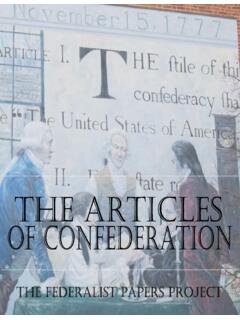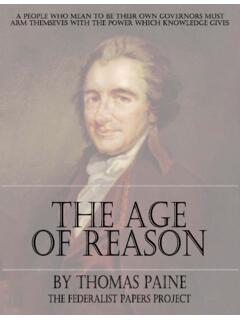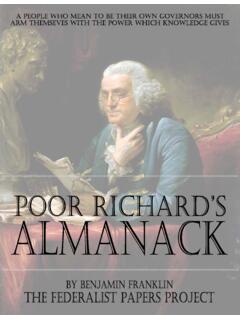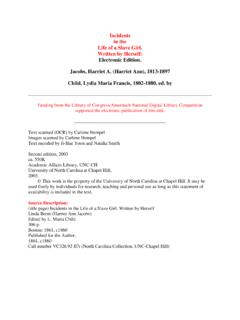Transcription of The Code of Hammurabi - The Federalist Papers
1 The Code of Hammurabi Page 1 THE CODE OF Hammurabi Edited by Steve Straub The Federalist Papers Project The Code of Hammurabi Page 2 TABLE OF CONTENTS INTRODUCTION .. 3 BABYLONIAN LAW--THE CODE OF Hammurabi .. 5 THE CODE OF Hammurabi ..18 CODE OF LAWS ..19 THE EPILOGUE ..38 The Code of Hammurabi Page 3 INTRODUCTION During the first two decades of his forty-two year reign ( ), Hammurabi fortified several cities in northern Babylonia. In 1764, Babylon defeated the coalition of Elam, Subartu and Eshnunna. By 1762, Hammurabi claimed to have "established the foundations of Sumer and Akkad, a phrase borrowed from Sumerian royal hymns to express the ideal of pan-Babylonian rule.
2 With the conquest of Mari in 1759, virtually all of Mesopotamia had come under Babylonian rule. Hammurabi then created his code of laws, which consists of 282 laws, in the year 1750 BC. The Code of Hammurabi is the longest surviving text from the Old Babylonian period. Almost completely preserved, the code is far more significant in legal history than any of its forerunners. The Code of Hammurabi was inscribed on stone, which suggests that the King accepted the laws from the sun god, Shamash. The code of laws encouraged people to accept authority of a king, who was trying to give common rules to govern the subjects' behavior. The Code of Hammurabi begins with a prologue, which describes the time that Hammurabi first becomes king, as evident in this quote: "Anu (King of Anunaki) and Bel (Lord of Heaven and Earth) called by name me Hammurabi , the exalted bring about the rule of righteousness in the land to destroy the wicked and the evil doers so that the strong should not harm the weak so that I should rule over the black headed people like Shamash and enlighten the land to further the well being of mankind.
3 " The actual laws range from public to private matters, with humane approaches to human problems. The laws include almost everything: marriage and family relations; negligence; fraud; commercial contracts; duties of public officials; property and inheritance; crimes and punishments; techniques of legal procedure; protection for women, children, and slaves; fairness in commercial exchanges; protection of property; standard procedures for adjudicating disputes; debt relief for victims of food and drought; and the list goes on to explain, in detail, each and every one of these instances. The code of laws is then ended with a epilogue, where Hammurabi declares the he is the rightful king: " Hammurabi is a ruler who is as a father to his subjects, who holds the words of Marduk in reverence, who has achieved conquest for Marduk over the north and south, who rejects the heart of Marduk, his lord, who has bestowed benefits for ever and ever on his subjects, and has established order in the land.
4 " The code of laws applied to the entire Babylonian society. The penalties of the code varied according to the status of the victim. There were three classes in the Babylonian society: the The Code of Hammurabi Page 4 patrician, who were the free men and women; the plebeians, who were the commoners; and the slaves. While the patricians were protected by the law of retaliation, the lower classes received only monetary compensation. The purpose of the Code of Hammurabi was to use political power to create common bonds among the diverse people of the society. It greatly influenced a total dependence on the power of their one ruler, and it was a conscious effort to exalt the king as the source, the only source, of earthly powers.
5 It unified the empire by offering the standards for moral values, class structure, gender relationships, and religion. The Code of Hammurabi Page 5 BABYLONIAN LAW--THE CODE OF Hammurabi . The material for the study of Babylonian law is singularly extensive without being exhaustive. The so-called "contracts," including a great variety of deeds, conveyances, bonds, receipts, accounts and, most important of all, the actual legal decisions given by the judges in the law courts, exist in thousands. Historical inscriptions, royal charters and rescripts, despatches, private letters and the general literature afford welcome supplementary information. Even grammatical and lexicographical works, intended solely to facilitate the study of ancient literature, contain many extracts or short sentences bearing on law and custom.
6 The so-called "Sumerian Family Laws" are thus preserved. The discovery of the now celebrated Code of Hammurabi (hereinafter simply termed the Code) has, however, made a more systematic study possible than could have resulted from the classification and interpretation of the other material. Some fragments of a later code exist and have been published; but there still remain many points upon which we have no evidence. This material dates from the earliest times down to the commencement of our era. The evidence upon a particular point may be very full at one period and almost entirely lacking at another. The Code forms the backbone of the skeleton sketch which is here reconstructed.
7 The fragments of it which have been recovered from Assur-bani-pal's library at Nineveh and later Babylonian copies show that it was studied, divided into chapters entitled Ninu ilu sirum from its opening words, and recopied for fifteen hundred years or more. The greater part of It remained in force, even though the Persian, Greek and Parthian conquests, which affected private life in Babylonia very little, and it survived to influence Syro-Roman and later Mahommedan law in Mesopotamia. The law and custom which preceded the Code we shall call "early," that of the New Babylonian empire (as well as the Persian, Greek, &c.) "late." The law in Assyria was derived from Babylonia but conserved early features long after they had disappeared elsewhere.
8 When the Semitic tribes settled in the cities of Babylonia, their tribal custom passed over into city law. The early history of the country is the story of a struggle for supremacy between the cities. A metropolis demanded tribute and military support from its subject cities but left their local cults and customs unaffected. The city rights and usages were respected by kings and conquerors alike. As late as the accession of Assur-bani-pal and Samas-sum-yukin we find the Babylonians appealing to their city laws that groups of aliens to the number of twenty at a time were free to enter the city, that foreign women once married to Babylonian husbands could not be enslaved and that not even a dog that entered the city could be put to death untried.
9 The population of Babylonia was of many races from early times and intercommunication between the cities was incessant. Every city had a large number of resident aliens. This freedom of intercourse must have tended to assimilate custom. It was, however, reserved for the genius of Hammurabi to make Babylon his metropolis and weld together his vast empire by a uniform system of law. The Code of Hammurabi Page 6 Almost all trace of tribal custom has already disappeared from the law of the Code. It is state-law; - alike self-help, blood-feud, marriage by capture, are absent; though family solidarity, district responsibility, ordeal, the lex talionis, are primitive features that remain.
10 The king is a benevolent autocrat, easily accessible to all his subjects, both able and willing to protect the weak against the highest-placed oppressor. The royal power, however, can only pardon when private resentment is appeased. The judges are strictly supervised and appeal is allowed. The whole land is covered with feudal holdings, masters of the levy, police, &c. There is a regular postal system. The pax Babylonica is so assured that private individuals do not hesitate to ride in their carriage from Babylon to the coast of the Mediterranean. The position of women is free and dignified. The Code did not merely embody contemporary custom or conserve ancient law.










